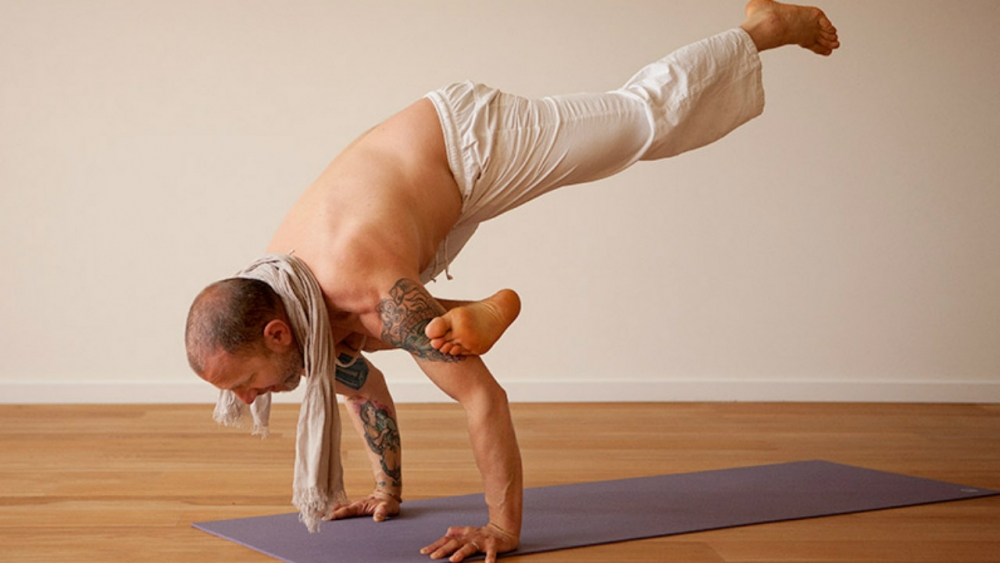Flying like a bird in the sky
The arm balance Eka Pada Galavasana, often referred to as “Flying Crow” is a pose that gives us the experience of doing just that: flying. The pose is a dynamic play between the stability and steadiness of the body and the graceful “seesawing” between the upper and lower body. Too much of one thing or the other and you’ll land on your nose!
I love practising arm balances and this one in particular because I get a sense of juggling 6 balls in the air when I practise it!
My hands needs to be anchored to the mat, my arms strong yet flexible to adjust my stance, my belly engaged and one foot firmly holding on to the outside of my upper arm, making it as stable as possible, while the other leg needs to have a sense of engaged lightness. It gives me the experience of being fully engaged and at the same time it makes me feel light. Serious and playful. My mind is an equal player in this pose as it needs to stay completely present and figure out what I need to do more of, or less of, to find the place of balance.
Focus, arm strength and hip opening
Since arm balances require focus, arm strength and hip opening, they are best performed when your body is sufficiently warmed up. The arm, chest and abdominal muscles need to be active and engaged. Furthermore, you want to have practised a few deeper hip openers, like Eka Pada Rajakapotasana (One Legged Pigeon pose) and Baby Cradle pose, so the hips can handle the stance.
Arm balances need to have your total attention and since this Eka Pada Galavasana is also an asymmetrical pose, focus applies even more as the imbalance in the posture makes it a more delicate proposition.
- Try my series of classes in the yoga programme Arm balance essentials, to help yourself to build up to this pose.
Common misalignments
Wrists
Many students experience some wrist pain when they start out practising arm balances. This pain will usually dissolve with building up strength in the hands and forearms and as the wrists will become more flexible over time. So, stretching the wrists is also important; there is a lot of connective tissue in the hands and wrists and often times this tissue feels stiff and inflexible.
- See my Wrist flow class if you would like some guidance on working this area.
Balance
Finding balance in the pose can be achieved when there is a balance between strength and softness by means of “melting the heart.” In other words; the chest needs to come forward of the wrists and elbows (like Chaturanga arms) and have a sense of surrender. You are kind of like a bird trusting that the wind will carry him as soon as he flaps his wings and drops out of the nest.
- Watch David’s free Chaturanga workshop to understand Chaturanga arms
Coming into the pose and modifications
After practising a fair amount of Surya Namaskars and hip opening poses, you can practise the more basic arm balance Bakasana, to get a sense of what actions are needed for Eka Pada Galavasana. When you feel warmed up, strong and open, you are ready to start practising it.
- Come to Tadasana, cross your left ankle over your right knee and bend forward. Place your hands shoulder width on the mat, fingertips first, then the pads at the base of the fingers, then heel of the hand last. Make sure your weight is evenly distributed over the whole of the hands. Now clamp your left toes on the outside of your right upper arm, hooking it firmly as you bend down further. (you may need to step your right foot a bit further away from your hands to do this). Bend your elbows to about 90 degrees, like the position your arms are in when doing Chaturanga.
- Now, breathe. Relax your face, and soften your chest more toward the floor, like a bird peeping over the edge of its nest! Stay strong and confident and move your weight into your hands and arms and see if you your right foot becomes a little lighter. Do not try to jump into the pose, but rather see if the “seesawing” of the chest moving down, will make it possible to gently lift the right foot off the mat.
Modification
If you are unsure about moving the chest down, you can try placing a block on the floor between your hands and place your head on it. The right foot will now be a lot easier to lift off of the floor and you can have a feel for the lightness of the pose while remaining stable with the head on the mat. You can practise this too when you want to learn to extend the right leg fully.
If you can get your foot off the floor, stay steady and focused, engage your belly muscles strongly and create length in the body from the heart to your right foot. Slowly extend the right leg back, while keeping the balance of the chest moving down. With the full expression of the pose, the back leg is completely straight. Repeat on the other side.
- Practise this pose with me in my Fly like a bird – Arm balance class

